Complete Solutions to Problem of chapter FORCE AND NEWTONS LAWS OF MOTION of Class 11 book with complete answers and questions
| Class 11 | PHYSICS |
| Chapter | FORCE AND NEWTONS LAWS OF MOTION |
| GRB PUBLICATION | Problem |
| Number Of Questions | 33 |
| Academic Year | 2023-24 |
A cricket ball of mass 150 kg is moving with a velocity of `12 m//s` and is hit by a bat so that ball is turned back with a velocity of `20 m//s` . The force of the blow acts for 0.01 s on the ball . Find the average force exerted by the bat on the ball.
02:45View SolutionA body starting from rest slides on an inclined plane of lengths as shown in Calculate the time of descent and speed at the bottom. Find also
(a) distance covered in half the time of descent and
(b) time taken to cover half the distance
 06:14View Solution
06:14View SolutionA mass A is released from the top of a frictionless inclined plane 18 m long and reaches the bottom 3 sec later. At the instant when A is released, a second mass B is projected upwards along the plane from the bottom with a certain initial velocity. The mass B travels a distance up the plane, stops and returns to the bottom so that it arrives simultaneously with A. The two masses do not collide. Find the acc. and initial velocity of B. (How far up the inclined plane does B travel?)
04:40View SolutionWhat should be the length of the day so that the weight of a body on the equator of earth becomes zero ? Given that radius of earth is 6400 km and acceleration due to gravity on its surface is `9.8 m//s^(2)`
03:11View SolutionA block of metal weighing 2kg is resting on a frictionless plane. It is struck by a jet releasing water at a rate of 1kg/s and at a speed of 5 m/s. Calculate the initial acceleration of the block.
01:22View SolutionCalculate the volume of the balloon filled with hydrogen gas, which will be sufficient to lift a load of 25 kg in air. Given that the densities of air and hydrogen are `0.00129g//c c` and `0.00009 g//c c` respectively.
03:28View SolutionTwo blocks of mass `m=1` kg and `M=2` kg are in contact on a frictionless table. A horizontal force `F(=3N)` is applied to m. Find the force of contact between the blocks. Will the force of contact remain same if F is applied to M?
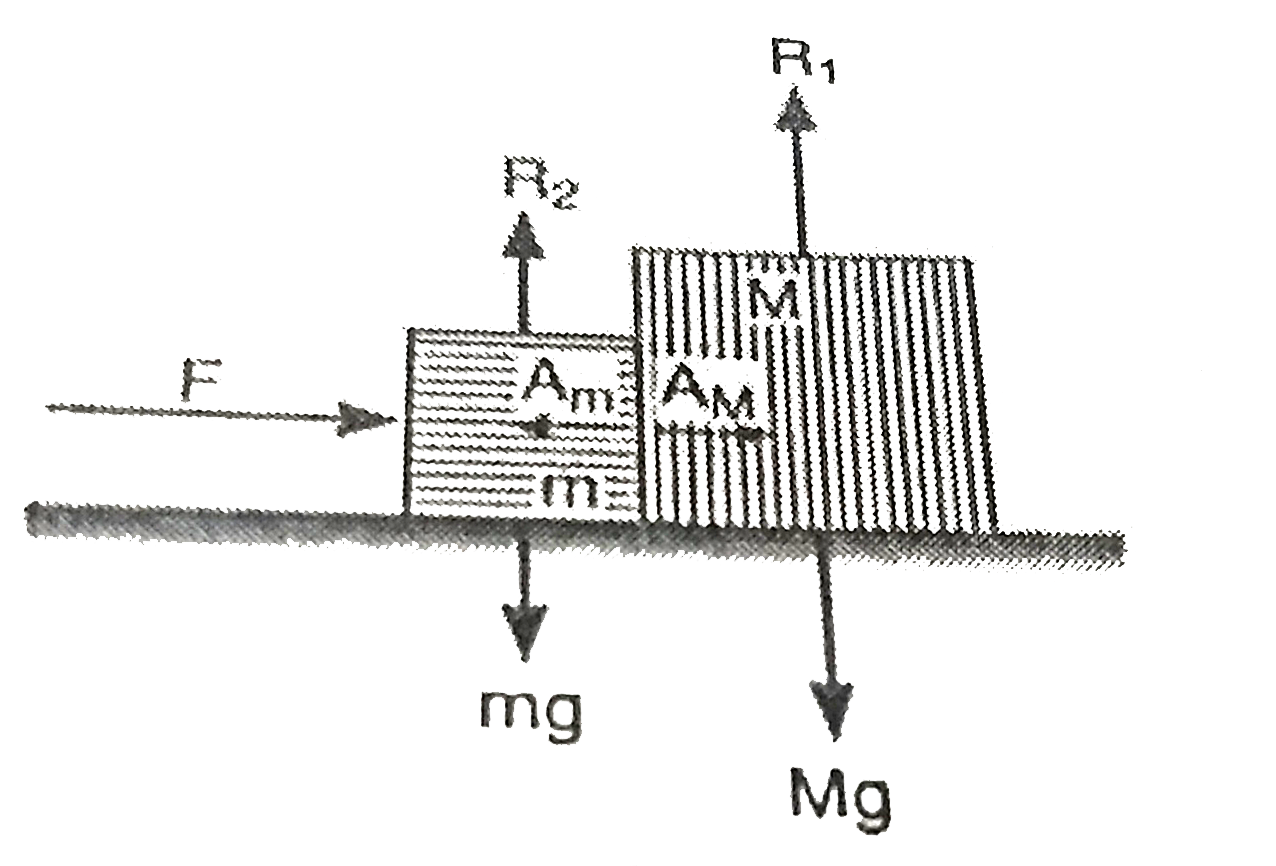 04:15View Solution
04:15View SolutionA lift is going up, the total mass of the lift and the passenger is 1500 kg. The variation in the speed of the lift is as shown in
(a) What will be the tension in the rope pulling the lift at,
(i) 1s
(ii) 6 s
(iii) 11 s
(b) What is the height to which the lift takes the passenger?
(c) What will be the average velocity and acceleration during the course of the entire motion? `(g=9.8m//s^(2))`View SolutionWith what minimum acceleration can a fireman slide down a rope whose breaking strength is `(2//3)` of his weight?
02:21View SolutionA body of mass m is suspended by two strings making angles `alpha and beta` with the horizontal. Find the tensions in the strings.
05:25View SolutionTwo particles, each of mass m, are connected by a light string of length `2L` as shown in A continuous force F is applied at the mid point of the string `(x=0)` at right angles to the initial position of the string. Show that acceleration of m in the direction at right angles to F is given by
`a_(x)=F/(2m)x/sqrt(L^(2)-x^(2))`
where x is the perpendicular distance of one of the particles from the line of action of F. Discuss the situation when `x=L`06:05View SolutionTwo blocks of masses 6 kg and 4 kg connected by a rope of mass 2 kg are resting on frictionless floor as shown in fig. If a constant force of 60 N is applied to 6 kg block, tension in the rope at A, B, and C will respectively be -
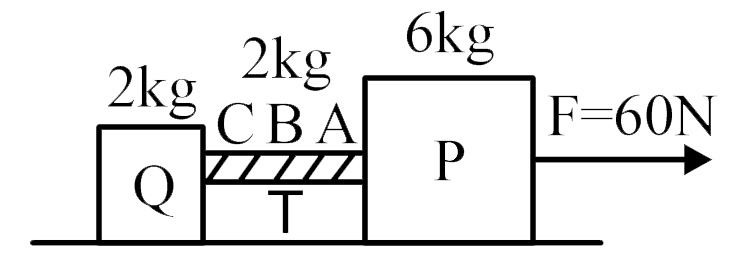 03:27View Solution
03:27View SolutionTwo blocks of masses 2.9 kg and 1.9 kg are suspended from a rigid support S by two inextensible wires each of length 1 m. The upper wire has negligible mass and the lower wire has a uniform mass of 0.2 kg/m. Thewhole system of block, wire and support have an upward acceleration of 0.2 m/s2. g = 9.8 m/s2. The tension at the mid-point of lower wire is-
 02:04View Solution
02:04View SolutionWhat is the tension in a rod of length length L and mass M at a distance y from`F_(1)` when the rod is acted on by two unequal force `F_(1)` and `F_(2) ( lt F_(1))` as shown in.
 04:31View Solution
04:31View SolutionA small mirror of area A and mass m is suspended in a vertical plane by a weightless string. A beam of light of intensity I falls normally on the mirror and the string is deflected from the vertical by a very small angle `theta` Assuming the mirror to be perfectly reflecting, obtain an expression for `theta`
07:57View SolutionThe pulley arrangements of Figs. (a) and (b) are identical. The mass of the rope is negligible. In (a) the mass m is lifted up by attaching a mass 2m to the other end of the rope. In (b), m is lifted up by pulling the other end of the rope with a constant downward force `F=2mg`. The acceleration of m is the same in both cases
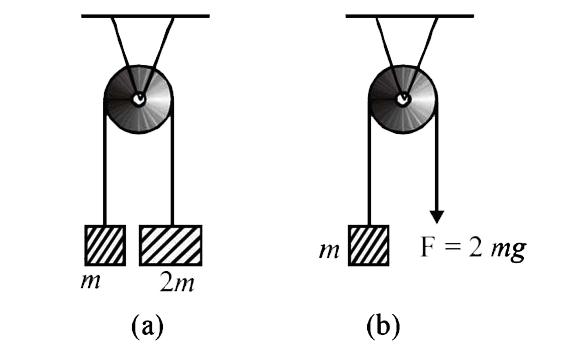 04:46View Solution
04:46View SolutionThree equal weights of mass m each are hanging on a string passing over a fixed pulley as shown in fig. The tensions in the string connecting weights A to B and B to C will respectively be -
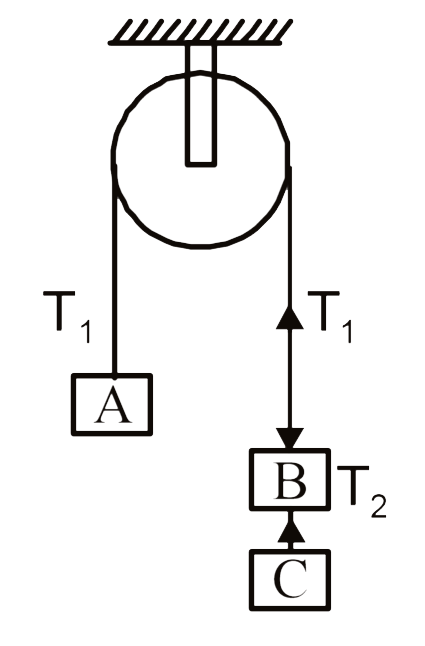 02:42View Solution
02:42View SolutionAn elevator and its load weigh a total of 166 kg. Find the tension T in the supporting cable when the elevator, originally moving downwards at `20m//s` is brought to rest with constant acceleration in a distance of 50 m.
03:49View SolutionIn the situation shown in figure, both the pulleys and the strings are light and all the surfaces are frictionless. The acceleration of mass M, tension in the string PQ and force exerted by the clamp on the pulley, will respectively be -
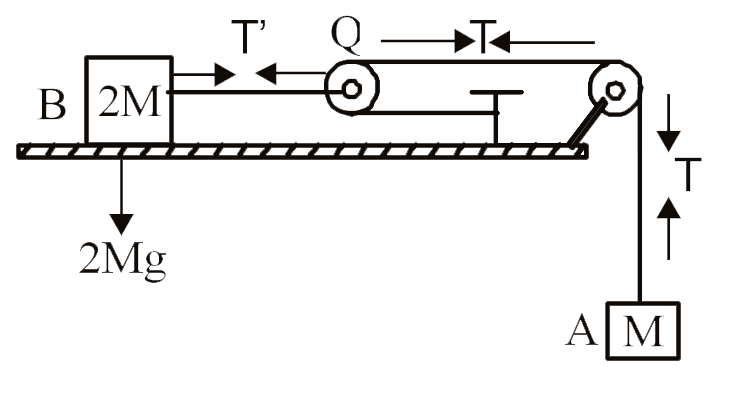 04:31View Solution
04:31View SolutionA monkey of mass m climbs up to a rope hung over a fixed pulley. The opposite end of the rope is tied to a weight of mass M lying on a horizontal plane. Neglecting the friction, find the acceleration of both the bodies (relative to the plane) and the tension of the rope for the three cases:
(i) The monkey does not move with respect to the rope
(ii) The monkey moves upwards with respect to the rope with acceleration a.
(iii) The monkey moves downwards with respect to the rope, with acceleration a.04:12View SolutionTwo 100 g blocks hang at the ends of a light flexible cord passing over a small frictionless pulley. A 40 g block rests on the block an right and removed after 2 sec.
(a) How far will each block move in the first second after the 40 g block is removed?
(b) What was the tension in the cord before the 40 g block was removed?
(c) What was the tension in the cord supporting the pulley after the 40 g block was removed?03:31View SolutionA dynomometer D (a force meter ) is attached to two masses M = 10 kg and m = 1 kg . Force F = 2 kg f and f = 1 kgf are applied to the masses . What will applied to the masses . What will the dynamometer show if :
(a) F is applied to M and f ot m
(b) F is applied to m and f to M
(c) if M = m = 5 kg .
 03:43View Solution
03:43View SolutionA disc of mass `m_(2)` is placed on a table. A stiff spring is attached to it and is vertical. The other end of the spring is attached to a disc of mass `m_(1)` What minimum force should be applied to the upper disc to press the spring such that the lower disc is lifted off the table when the external force is suddenly removed?
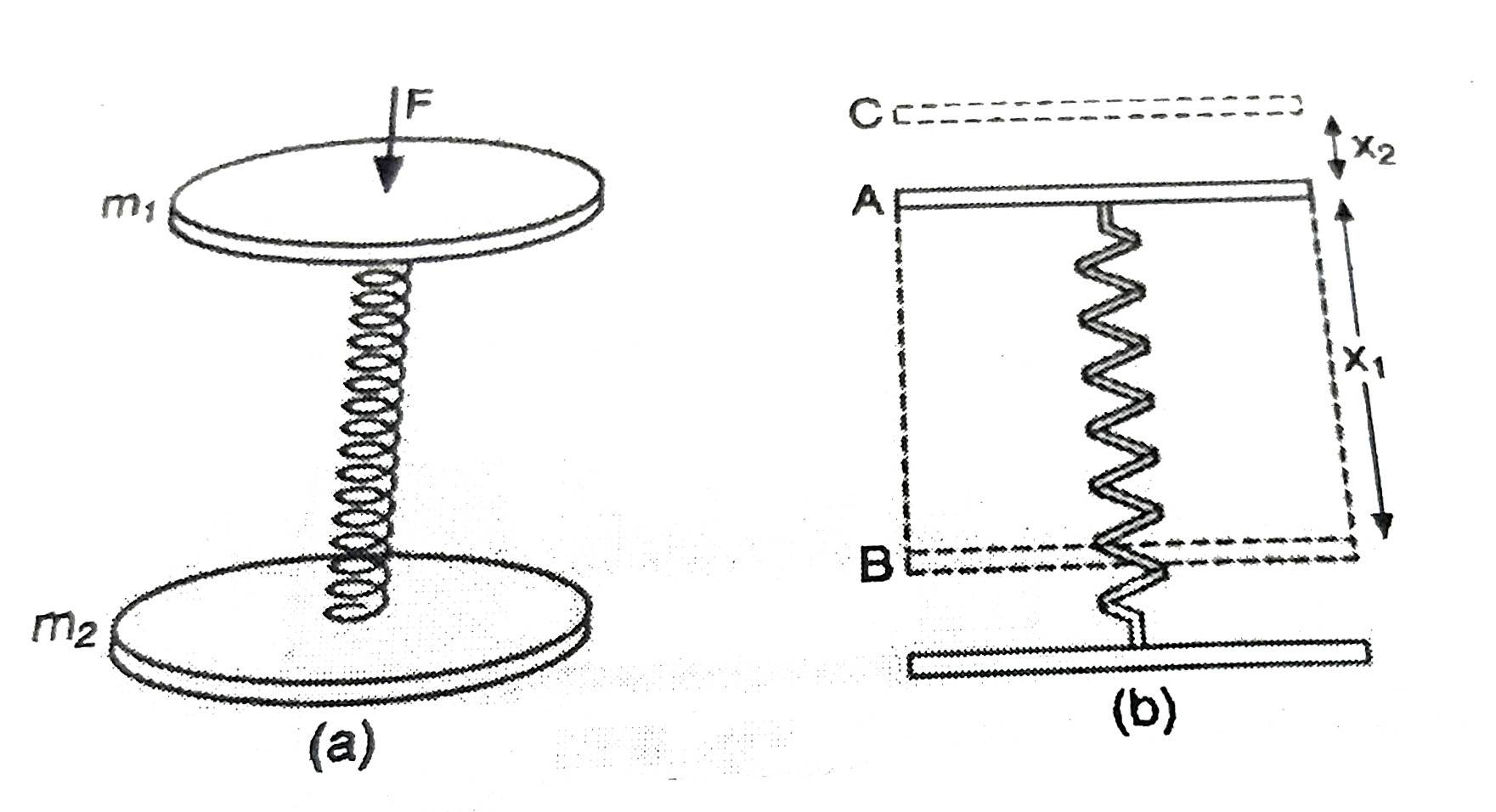 02:47View Solution
02:47View SolutionTwo blocks A and B are connected to each other by a string and a spring, the string passes over a frictionless pulley as shown in Block B slides over the horizontal surface of a stationary block C and the block. A slides along the vertical side of C, both with same uniform speed. The coefficient of friction between the surface of the blocks is 0.2 Force constant of the spring is 1960 `N//m` if the mass of block A is 2 kg calculate the mass of the block B and the energy stored in the spring.
04:01View SolutionOn applying a force F the mass M is displaced vertically down by from equilibrium position, Find the force F in terms of the force constant k of the spring and displacement y for the cases (A) and (B) as shown in
01:58View SolutionWhat are the rate of change of momenta of the pendulum bobs 1 and 2 as observed from the reference frames A and B respectively Find the net forces acting on the bobs relative to A and B in each case find the tension in the strings as viewed by both observers.
 View Solution
View SolutionAt wood machine is attached below the left hand pan of a physical balance while equal weight `(M+m)` g is placed in the right hand pan. The beam is horizontal when the masses M and m on the left hand side are braked What will happen if the masses M and m are unbraked on the left hand side?
02:52View SolutionFind the mass of the hanging block in which will prevent the smaller block of mass m from slipping over the triangular block of mass M. All the surfaces are frictionless and the strings and the pulleys are light
 04:34View Solution
04:34View SolutionIn the figure a painter of mass 100 kg pulls himself up with the crate of 25 kg with an acceleration. If the painter exerts an effective force of 450 N on the floor of the crate, find (a) the acceleration of the painter and
(b) the tension in the string taking `g=10 m//s^(2)`
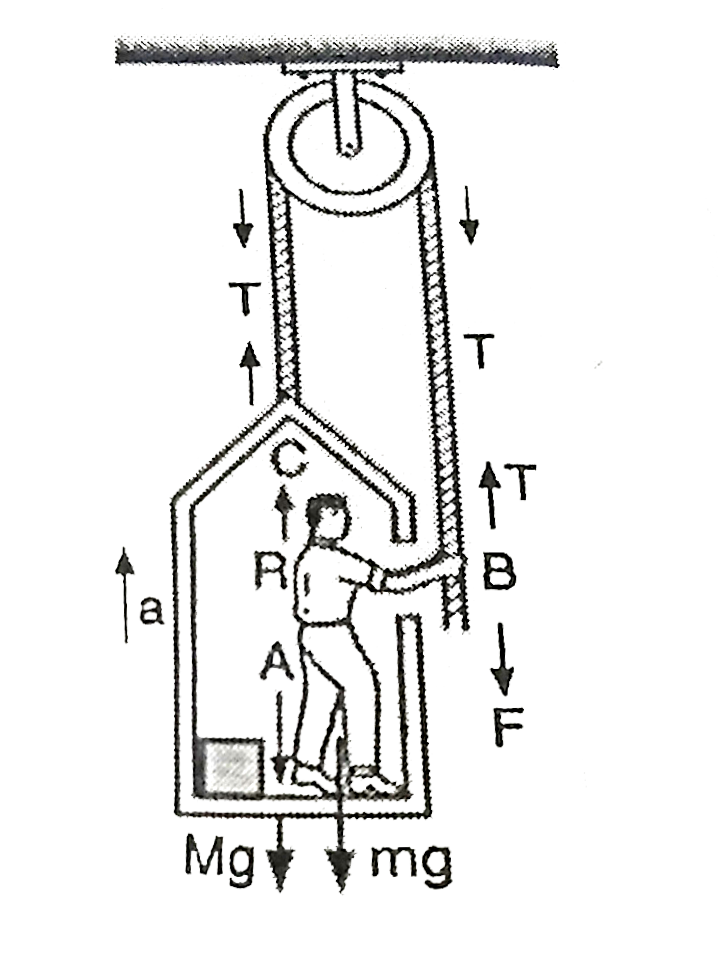 06:24View Solution
06:24View SolutionA very flexible uniform chain of mass M and length L is suspended vertically so that its lower and just touches the surface of a table. When the upper end of the chain is released it falls with each link coming to rest the instant it strikes the table. Find the force exerted by the chain on the table at the moment when y part of the chain has already rested on the table.
 02:13View Solution
02:13View SolutionOne end (say B) of a massless spring having force constant k is attached to a block lying on a smooth surface while the other end A is pulled by an external force At some instant the velocities of end A and B of the spring are `v_(A)` and `v_(B)` respectively. If the energy of the spring is increasing at the rate of `P J//s` find the instantaneous tension and stretch in the spring.
02:45View SolutionIn the pulley system shown the movable pulleys `A,B` and `C` have mass m each, `D` and `E` are fixed pulleys. The strings are vertical light and inextensible Then
 .10:05View Solution
.10:05View SolutionWrite equations of forces in terms of the relative acceleration for the blocks shown in and find the relation between m and M so that system remains at rest
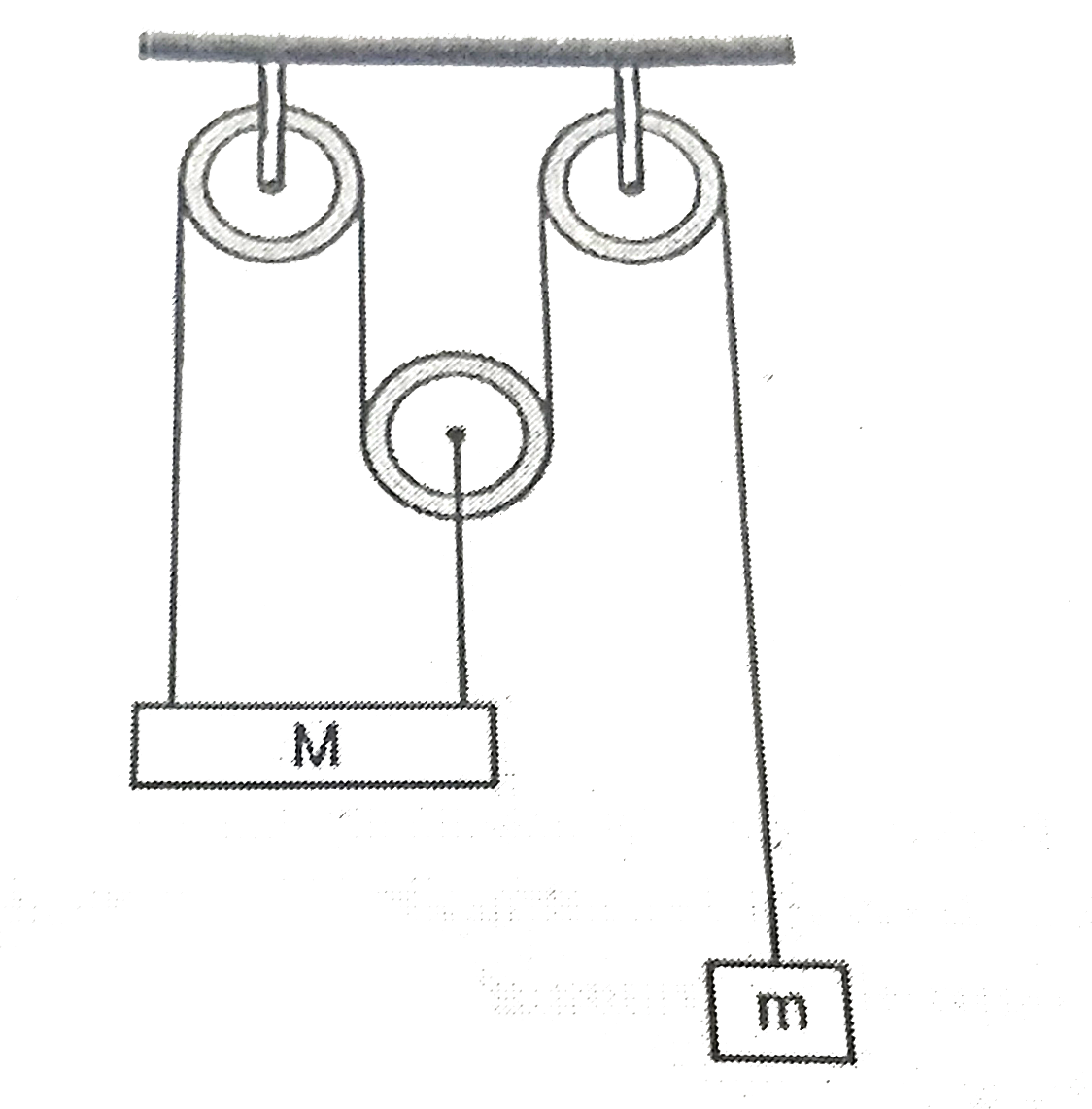 02:56View Solution
02:56View Solution
Problem questions and complete solutions for chapter FORCE AND NEWTONS LAWS OF MOTION of GR BATHLA & SONS PHYSICS (HINGLISH) of Class 11
